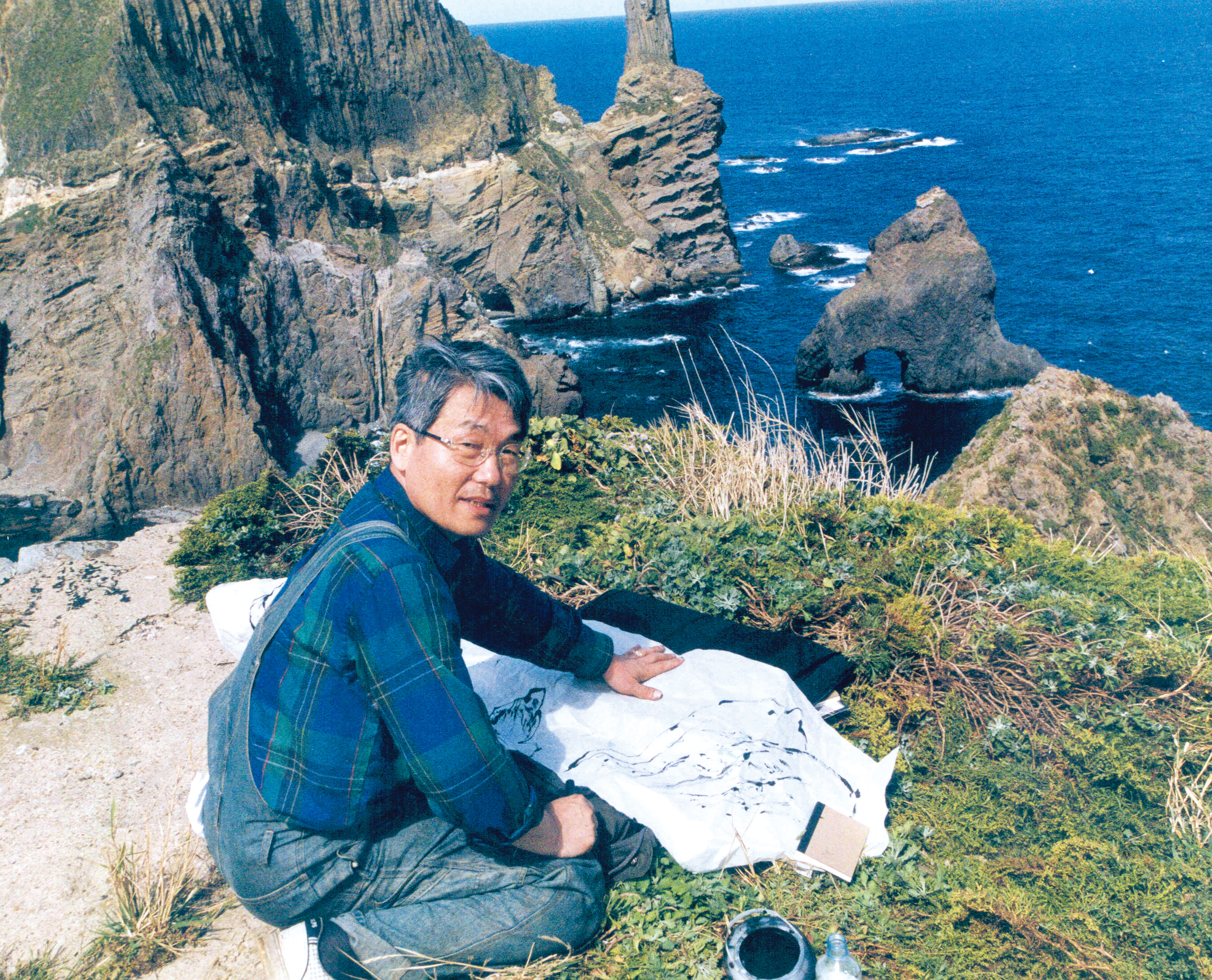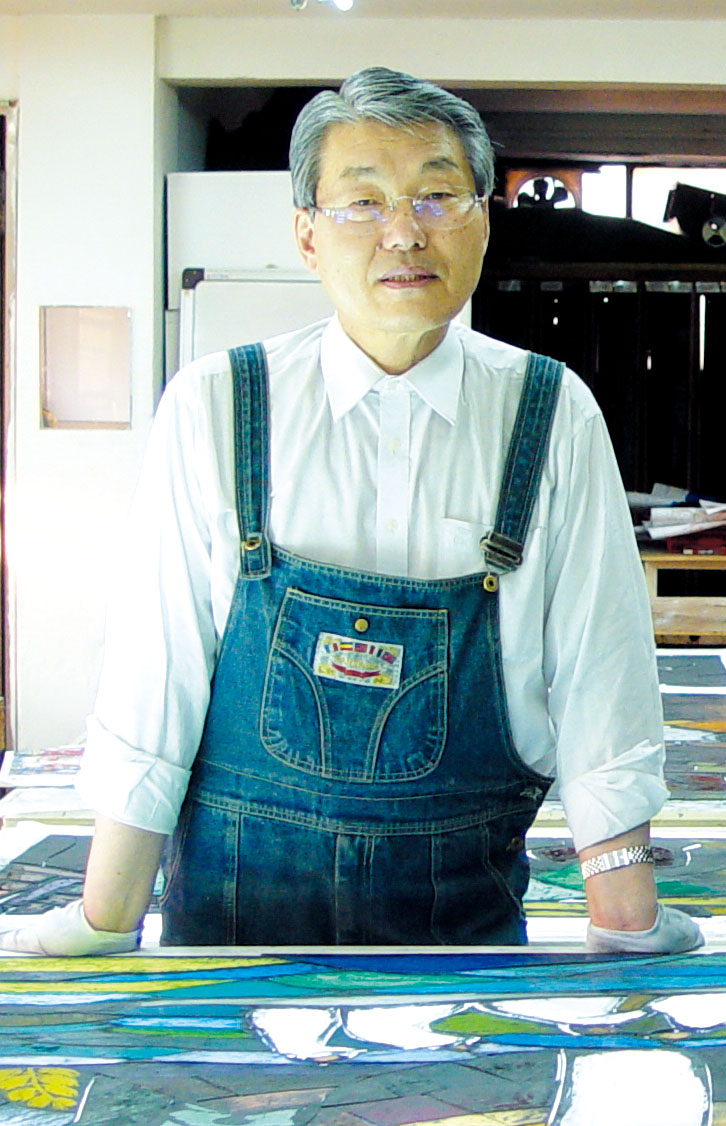Gaining Int'l Fame
Painter Lee Jong-sang joins with Lee Woo-hwan, and the late Kim Hwan-ki as Leeum Museum displays their artwork at the N.Y.Metropolitan Museum of Art












Master of Art Painter Lee Jong-sang is one of the three Korean artists whose art pieces, owned by the Leeum Museum, will be on display at the New York Metropolitan Museum of Art until Aug. 14. The other painters are Lee Woo-hwan and the late Kim Hwan-ki. Lee, who goes by his penname of Illang, is a painter as well as an installation artist and one of his most renowned works is a mural painting on volcanic rock on the wall of the Taebaek Mountain Cultural Hall in Bulkyo, Boseong County in South Jeolla Province. The mural was the first done on a volcanic rock and the largest such work in Korea is entitled, Urfigration-the Wish of Baekdu Great Mountain Range, earned him a certificate recognizing the work as the first such work done of such magnitude from the Korea Record Institution. He also gained fame when his installation mural painting depicting a French naval invasion of Gangwha Island in 1866 was displayed at Le Carrousel de Louvre at the famed Louvre Museum in Paris from 1997 to early 1998, attracting over 1 million viewers.
The artwork entitled, Urfigration-Mari Mountain (6 m x 72 m) became so popular that the French government wanted to buy the art piece, but Master Painter Lee wanted to sell it only when the French government would return historic assets belonging to the Jeoson Dynasty from its archives on Gangwha Island that the French naval fleet took with them from
Korea and the French government refused to comply. Following are excerpts of his recent rewritten interview with NewsWorld on his art and his philosophy on life:
Question: You are a member of the National Academy of Arts of the Republic of Korea, and have been very active in your artistic life and although you are well over 70 in age, you are as active as many young artists. You have been known for your deep knowledge of Korean history. You led the campaign to preserve Goguryeo culture in the 60s and 70s. In the 70s, you knew before anyone else in the artistic community of the encroaching conflict over Dokdo islet between Korea and Japan and acted as head of the Dokdo Island Culture Cultivation campaign which turned the territorial conflict into an NGO cultural campaign.
Answer: I have devoted my entire life to creative fine art. Through a long artistic life, I experienced various historic events including the Pacific war, the Korean war, the April 19 Student Uprising, which I was actively involved in, the May 16 Military Revolution, and the May 18 Democratic Revolution, as a member of a generation that went through all these key events in our history.
As an artist I show my experience of history in my artwork and under the strong feeling that I can keep my art and our territory as an artist and did my share of work in the age of the bamboo curtain to protect Goguryeo culture and prepare for Dokdo Territorial Rights issues because of my belief that political diplomacy and military power cannot always work to preserve national culture and territorial rights.
I predicted the Dokdo conflict and the Northeast History Make up by China to rewrite the history of Northeast China with art and cultural events well before they occurred. I had my hand in planning the Special Goguryeo Exhibition, the Goguryeo Clothes and Decorative Material Exhibit, the Balhae Exhibit and the Dokdo Special Exhibit for History and Conscience, among others as director of the Seoul National University Museum.
Q: On the outer Wall of the Taebaek Mountain Cultural Hall in Bulkyo, Boseong County, South Jeolla Province, is a mural entitled, Original Form-The Wish of Baekdu Great Mountain Range, one of your great works, that is officially recognized as the first mural on volcanic rock and the first and largest mural painting ever painted in Korea as recorded by the Korea Record Institute upon your receipt of the certificate on July 9.
The Taebaek Mountain, a novel written by author Cho Jong-rae discusses the national ideal for unification as its main theme and the wish for peace following unification. I would like to know the meaning of the original plastic form of art as it is originally intended in terms of history.
A: An outdoor Urfiguration-The Wish of the Baekdu Great Mountain Range is the first and largest such artwork built and designed by architect Kim Won in the Taebaek Mountain Range Literary Hall on the north wall of the hall, made with a natural rock construction method.
It is my art piece that attempted to express the national wish for unification by digging up the hidden national tragedy of fratricidal war in art form. The building is looking northward at the Taebaek Mountain Range in expression of the national wish for reunification and the mural is painted in flat form on a wall made with natural rock to create three dimensional space.
It is the largest outdoor new mural painting that carries the wish for national reunification and for peace that harmonizes literature, architecture and fine art in a single space that mixes literature and architecture.
An artist should have a great sense for history with the artistic sense and ability to express the history of his age and reveal a vision for future in his or her artwork.
I hope I can get the certificate for the mural being the world's best now that it won a certificate from the Korea Record Institute it is the first and largest mural on natural rock as the result of three inspections by the institute before issuing the certificate.
Q: Your historic understanding and interest in political and societal matters, search for a national culture, the root of our livelihood, and your installation pieces that reflect Korean traditional beauty were put on display at Le Carrousel du Louvre at Louvre Museum in Paris for the first time for a living artist and attracted great attention from art-lovers around the world. Currently, you are holding a three-artist exhibition at the New York Metropolitan Museum of Art with fellow renowned Korean artists Lee Woo-hwan, who is simultaneously holding an individual exhibition at the Guggenheim Museum and the late Kim Hwan-ki, receiving tremendous acclaim from art fans. Do have anything to say to up-and-coming artists trying to follow your footsteps?
A: I am very honored to have my artwork on display at the New York Metropolitan Museum of Art alongside two senior Korean artists who not only represent Korea, but also modern fine arts, and the exhibition is slated to tour the United States. From 1997 to early 1998, my installation mural work, Urfigration-Mari Mountain (6 m x 72 m) was put on display at French President Mitterrand Gran Louvre Exhibition with the support of the Thompson Group, which took place at Le Carrousel du Louvre of Louvre Museum. The installation mural art piece had as its main theme the Western (French Fleet) Invasion of Gangwha Island off Incheon in the year of Byungin (1866). The event attracted some 1.27 million viewers.
The Louvre wanted to extend the exhibition three times, but when 1998 passed without any tangible results, and the French government wanted to buy the art piece and put it on display permanently at the Louvre. I told them that I would sell the art piece if the French government would return all papers they took away from the Kyujang-kak, a royal record storage on Gangwha Island when the French fleet invaded the island in 1866 to protest the suppression of Catholics during the reign of King Kojong in the Jeoson Dynasty led by Daewon-gun, the father of King Kojong.
Several days later, clerics of the Incheon Catholic parish issued a statement calling for the return of the national treasure from France, which refused by saying that it was a political matter. I said I could not sell my art piece due to my cultural self-esteem.
Modern fine art pieces by three Korean painters owned by Leeum Museum and punchong pottery pieces of the Jeoson Dynasty are on display at the New York Metropolitan Museum of Art.
The exhibition will close on Aug. 14 and go on a tour of the United States and I would like to see the exhibit on display have Korean tradition as the main theme, especially, the Korean Ondol floor heating system. They had floor papers from Korean ondol rooms and painted on them with ink. The room with floor heating systems called ondol goes back to the Goguryeo dynasty and Koreans have been living on floors covered with papers for thousands of years.
Liberal brush work with iron powders on those ondol papers result in purely Korean modern paintings. We have to think about Koreans as a race of people who built an eternal culture of living on papered floors and expensive carpets that only the richest on earth could do. That's why I say if one wants to see the future, he should visit a museum, and if one wants to look back at the past, then go to a modern fine arts museum. Tradition and creativity are two clearly different things. But if you recognize the difference and harmonize them through communication, the differences based on cultural contact would be the cause for creativity.
A spear and a shield are made to do different things, but when a soldier has a spear in one hand and a shield in another and use them appropriately, he becomes a strong soldier.
This is my contradictory philosophy of spirit and body and actions and ideals. This is what I have: communication, persuasion and harmony for self-generated thoughts, a beauty of embracing.
Life and art and all others don't have completion, only non finito'incomplete processes, with no past and future, only the present. You should be faithful at present, and only then can you count on a sound past and future, I believe. That's why an artist should not fear getting old, but fear dilapidation. nw
Urfigration-Great Land; 170 cm x 234 cm; Floor Paper; 1990; On display at New York Metropolitan Museum of Art.
Painter Lee in front of the portrait of Shinsaimdang, a noted female scholar in the late Jeoson Dynasty (1395-1910) which he painted and later put on the 50,000 won Korean currency in 2009. His portrait of Yulgok, son of Shinsaimdang, the late Jeoson Dynasty scholar was also put on the 5,000 won currency.
(from top)Dokdo; Ki or Spirit; 70 cm x 70cm; Ink; Floor Paper; 1982.
Painter Lee at work painting Dokdo, which he toured and painted for the first time in 2010.
Urfigration-Land; 170 cm x 234 cm; Ink; Floor Paper; 1990
Urfigration-DMZ; 160 cm x 130 cm; Ink and Natural Dye; Korean Paper; 1
(from top)Urfigration-Heavenly Lake; 370 cm x 900 cm; Mural on Bronze; 1997
Urfigration-Fatherland; 143 cm x 189 cm; Oil on Copper Plate; 1991; Collection of Leeum Museum.
Painter Lee at work on glass-painting in his studio in 2005.
Painter Lee examines a Goguryeo Dynasty mural in Deokheung-ri, North Korea in 1999.
Photos on Courtesy of painter Lee jong-sang
Photos by NewsWorld
3Fl, 292-47, Shindang 6-dong, Chung-gu, Seoul, Korea 100-456
Tel : 82-2-2235-6114 / Fax : 82-2-2235-0799